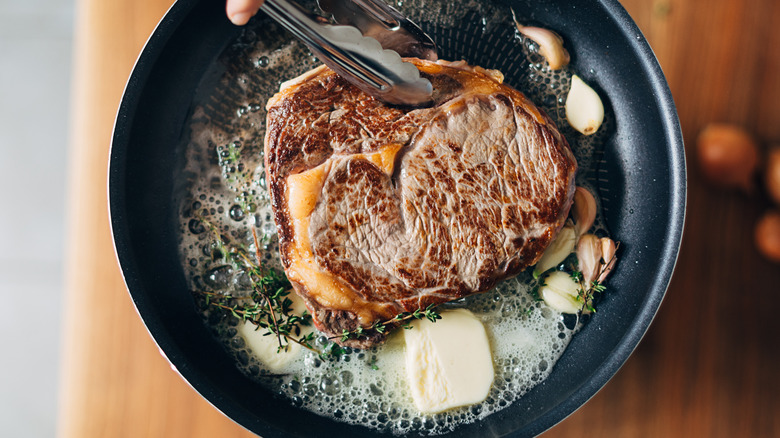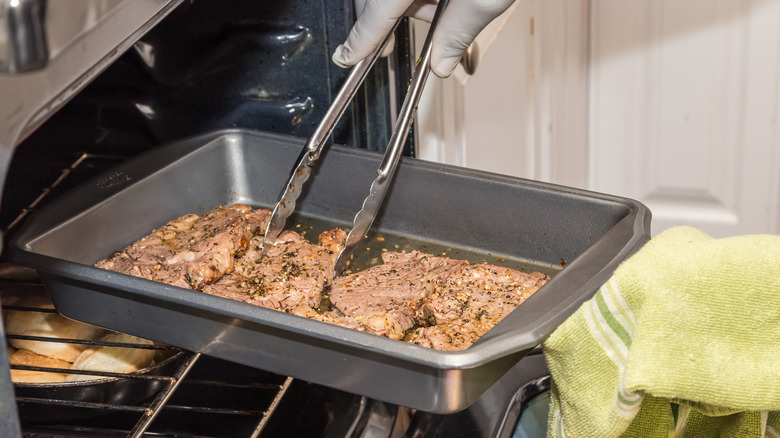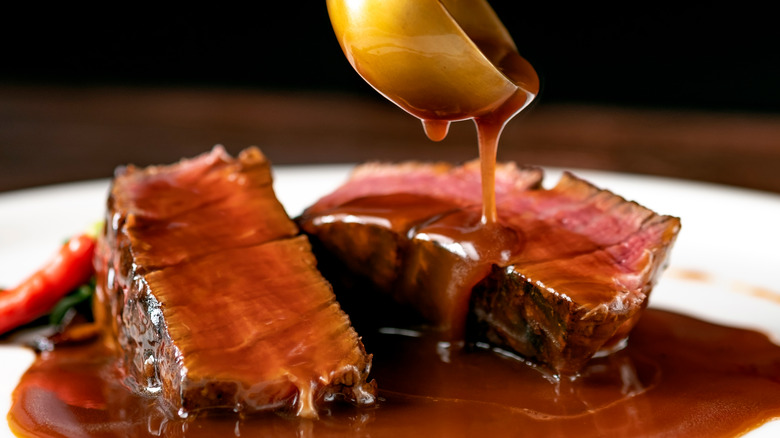The Downside Of Reverse-Searing That No One Talks About
If you tend to overcook expensive cuts of meat in pursuit of the perfect crust or quadriller hash marks, reverse-searing is a more forgiving cooking technique that increases your odds of a perfectly cooked medium-rare steak with a flavorful crust. Like everything else in life, however, the slow and steady method has downsides and eliminates a critical ingredient if you have a pan sauce in mind.
Reverse searing in a pan prevents the formation of fond — those browned bits of meat that stick to the pan. Fond is the result of the Maillard reaction, a chemical process that caramelizes sugars and proteins to create new aromas, flavors, and colors. With high heat and low moisture, the Maillard reaction is responsible for the golden-brown crust on pies, bread, and roasted vegetables and is the crowning achievement for seared meats.
When a pan is deglazed with a liquid (water, wine, stock, or broth), those caramelized pieces loosen, adding a depth of flavor to sauces, braises, and stews. Since reverse-seared meat browns quickly, it doesn't have time to leave fond in the pan. However, this means that all the flavor still clings to the meat, and a pan sauce can be whipped up using the meat drippings from the first cooking stage.
How to reverse sear
Despite the inherent downside of reverse-searing, which compromises the formation of fond, the technique has managed to garner popularity among chefs, revealing its own merits. Searing is a critical flavor-building step, and up until the early 2000s, chefs traditionally seared all cuts of meat at the beginning of the cooking process to "lock in the juices." Thicker cuts of meat then went into the oven to finish cooking. While this is still the preferred method for thin cuts of meat like skirt steak, the traditional technique creates uneven cooking for thicker cuts, leaving the beef along the perimeter grey and overcooked since proteins cook from the edges inward.
Chefs like Andrew Zimmern prefer to reverse sear expensive, thick cuts of meat (one-and-a-half to two-inches thick) like filet mignon, porterhouse, and tomahawk steaks. This two-step process first cooks the meat gently over indirect heat in a 250-degree oven, sous vide, or on the cool side of a grill until it reaches 10 to 15 degrees below your target temperature. The meat is then seared in a sizzling hot cast iron pan or grilled directly over an open flame to develop a crust and finish cooking.
For medium-rare steaks, cook thick cuts in the oven for roughly 25 to 30 minutes until they reach 115 degrees with a thermometer. Sear the meat on both sides until golden brown, then allow the steak to rest until it reaches 130 degrees. Extend the initial oven cooking time by about five minutes for medium doneness, searing the steaks when they hit 125 degrees for a final temperature of 140 degrees.
How to make a pan sauce from the drippings
While reverse searing takes longer than traditional searing, it allows the cook more time to achieve the perfect doneness. A reverse-seared steak will be juicy and delicious, and you can still make a flavorful pan sauce with the meat drippings.
As the meat rests, over medium heat, sauté aromatics like minced shallots, onions, or garlic in two tablespoons of oil. Add any meat drippings accumulated during baking and stock, wine, or broth, and bring them to a boil. Scrape the bottom of the pan with a wooden spoon, loosening any caramelized veggies, and allow the liquid to reduce by half.
Remove the pan from the heat and add a generous knob of butter and fresh herbs, swirling the pan as the butter melts to emulsify the sauce. Season the pan sauce with salt and pepper and drizzle it on your perfectly cooked steak.
For a peppery au Poivre sauce, deglaze the pan with cognac and whisk in mustard, crème fraîche, lemon juice, and water once the alcohol burns off. Season with salt, fresh parsley, and lemon zest, and spoon the sauce over filet mignon or skip the pan sauce entirely and make a fresh chimichurri sauce with garlic and herbs.



